Yuxuan Zhou
Evaluating LLMs Across Multi-Cognitive Levels: From Medical Knowledge Mastery to Scenario-Based Problem Solving
Jun 10, 2025Abstract:Large language models (LLMs) have demonstrated remarkable performance on various medical benchmarks, but their capabilities across different cognitive levels remain underexplored. Inspired by Bloom's Taxonomy, we propose a multi-cognitive-level evaluation framework for assessing LLMs in the medical domain in this study. The framework integrates existing medical datasets and introduces tasks targeting three cognitive levels: preliminary knowledge grasp, comprehensive knowledge application, and scenario-based problem solving. Using this framework, we systematically evaluate state-of-the-art general and medical LLMs from six prominent families: Llama, Qwen, Gemma, Phi, GPT, and DeepSeek. Our findings reveal a significant performance decline as cognitive complexity increases across evaluated models, with model size playing a more critical role in performance at higher cognitive levels. Our study highlights the need to enhance LLMs' medical capabilities at higher cognitive levels and provides insights for developing LLMs suited to real-world medical applications.
Uni-MuMER: Unified Multi-Task Fine-Tuning of Vision-Language Model for Handwritten Mathematical Expression Recognition
May 29, 2025Abstract:Handwritten Mathematical Expression Recognition (HMER) remains a persistent challenge in Optical Character Recognition (OCR) due to the inherent freedom of symbol layout and variability in handwriting styles. Prior methods have faced performance bottlenecks, proposing isolated architectural modifications that are difficult to integrate coherently into a unified framework. Meanwhile, recent advances in pretrained vision-language models (VLMs) have demonstrated strong cross-task generalization, offering a promising foundation for developing unified solutions. In this paper, we introduce Uni-MuMER, which fully fine-tunes a VLM for the HMER task without modifying its architecture, effectively injecting domain-specific knowledge into a generalist framework. Our method integrates three data-driven tasks: Tree-Aware Chain-of-Thought (Tree-CoT) for structured spatial reasoning, Error-Driven Learning (EDL) for reducing confusion among visually similar characters, and Symbol Counting (SC) for improving recognition consistency in long expressions. Experiments on the CROHME and HME100K datasets show that Uni-MuMER achieves new state-of-the-art performance, surpassing the best lightweight specialized model SSAN by 16.31% and the top-performing VLM Gemini2.5-flash by 24.42% in the zero-shot setting. Our datasets, models, and code are open-sourced at: https://github.com/BFlameSwift/Uni-MuMER
Predicting Diabetic Macular Edema Treatment Responses Using OCT: Dataset and Methods of APTOS Competition
May 09, 2025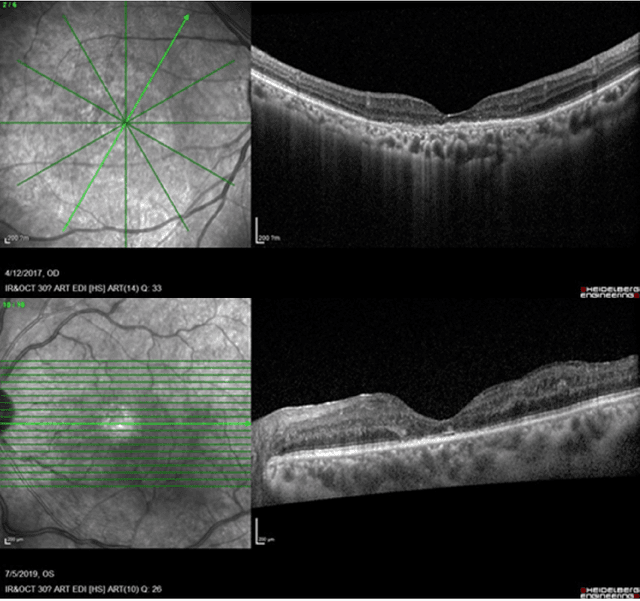
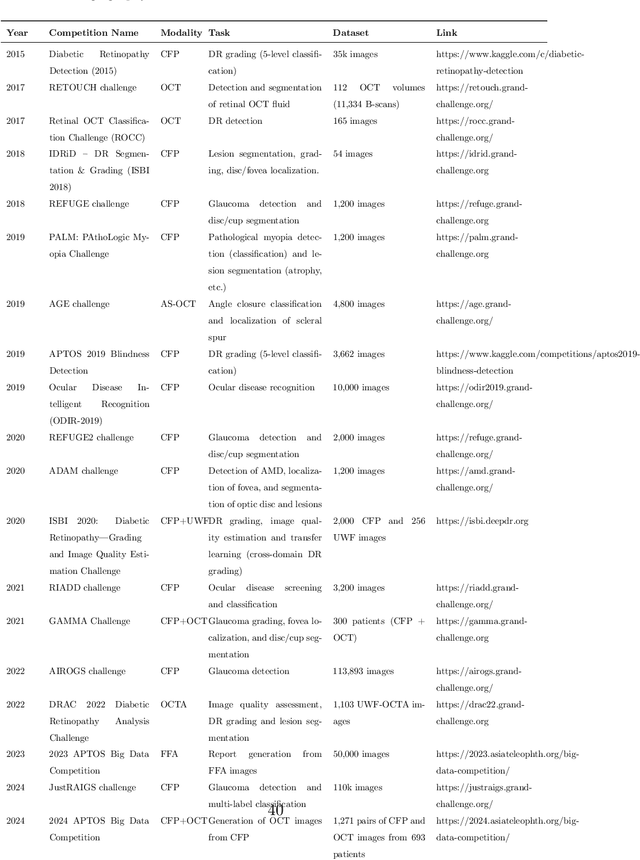
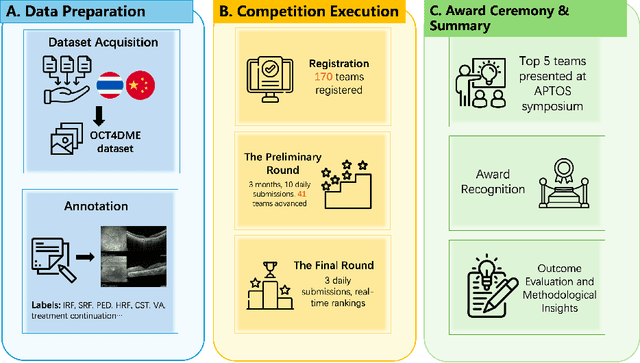

Abstract:Diabetic macular edema (DME) significantly contributes to visual impairment in diabetic patients. Treatment responses to intravitreal therapies vary, highlighting the need for patient stratification to predict therapeutic benefits and enable personalized strategies. To our knowledge, this study is the first to explore pre-treatment stratification for predicting DME treatment responses. To advance this research, we organized the 2nd Asia-Pacific Tele-Ophthalmology Society (APTOS) Big Data Competition in 2021. The competition focused on improving predictive accuracy for anti-VEGF therapy responses using ophthalmic OCT images. We provided a dataset containing tens of thousands of OCT images from 2,000 patients with labels across four sub-tasks. This paper details the competition's structure, dataset, leading methods, and evaluation metrics. The competition attracted strong scientific community participation, with 170 teams initially registering and 41 reaching the final round. The top-performing team achieved an AUC of 80.06%, highlighting the potential of AI in personalized DME treatment and clinical decision-making.
S3MOT: Monocular 3D Object Tracking with Selective State Space Model
Apr 25, 2025Abstract:Accurate and reliable multi-object tracking (MOT) in 3D space is essential for advancing robotics and computer vision applications. However, it remains a significant challenge in monocular setups due to the difficulty of mining 3D spatiotemporal associations from 2D video streams. In this work, we present three innovative techniques to enhance the fusion and exploitation of heterogeneous cues for monocular 3D MOT: (1) we introduce the Hungarian State Space Model (HSSM), a novel data association mechanism that compresses contextual tracking cues across multiple paths, enabling efficient and comprehensive assignment decisions with linear complexity. HSSM features a global receptive field and dynamic weights, in contrast to traditional linear assignment algorithms that rely on hand-crafted association costs. (2) We propose Fully Convolutional One-stage Embedding (FCOE), which eliminates ROI pooling by directly using dense feature maps for contrastive learning, thus improving object re-identification accuracy under challenging conditions such as varying viewpoints and lighting. (3) We enhance 6-DoF pose estimation through VeloSSM, an encoder-decoder architecture that models temporal dependencies in velocity to capture motion dynamics, overcoming the limitations of frame-based 3D inference. Experiments on the KITTI public test benchmark demonstrate the effectiveness of our method, achieving a new state-of-the-art performance of 76.86~HOTA at 31~FPS. Our approach outperforms the previous best by significant margins of +2.63~HOTA and +3.62~AssA, showcasing its robustness and efficiency for monocular 3D MOT tasks. The code and models are available at https://github.com/bytepioneerX/s3mot.
Secure Transfer Learning: Training Clean Models Against Backdoor in (Both) Pre-trained Encoders and Downstream Datasets
Apr 16, 2025Abstract:Transfer learning from pre-trained encoders has become essential in modern machine learning, enabling efficient model adaptation across diverse tasks. However, this combination of pre-training and downstream adaptation creates an expanded attack surface, exposing models to sophisticated backdoor embeddings at both the encoder and dataset levels--an area often overlooked in prior research. Additionally, the limited computational resources typically available to users of pre-trained encoders constrain the effectiveness of generic backdoor defenses compared to end-to-end training from scratch. In this work, we investigate how to mitigate potential backdoor risks in resource-constrained transfer learning scenarios. Specifically, we conduct an exhaustive analysis of existing defense strategies, revealing that many follow a reactive workflow based on assumptions that do not scale to unknown threats, novel attack types, or different training paradigms. In response, we introduce a proactive mindset focused on identifying clean elements and propose the Trusted Core (T-Core) Bootstrapping framework, which emphasizes the importance of pinpointing trustworthy data and neurons to enhance model security. Our empirical evaluations demonstrate the effectiveness and superiority of T-Core, specifically assessing 5 encoder poisoning attacks, 7 dataset poisoning attacks, and 14 baseline defenses across five benchmark datasets, addressing four scenarios of 3 potential backdoor threats.
HA-VLN: A Benchmark for Human-Aware Navigation in Discrete-Continuous Environments with Dynamic Multi-Human Interactions, Real-World Validation, and an Open Leaderboard
Mar 18, 2025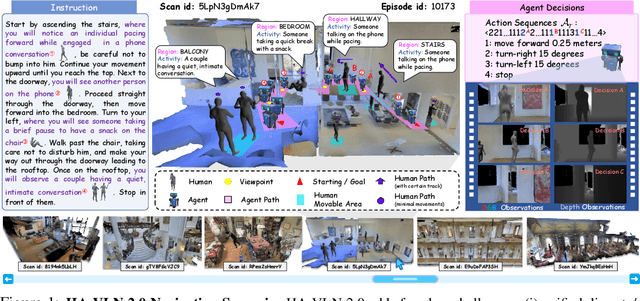
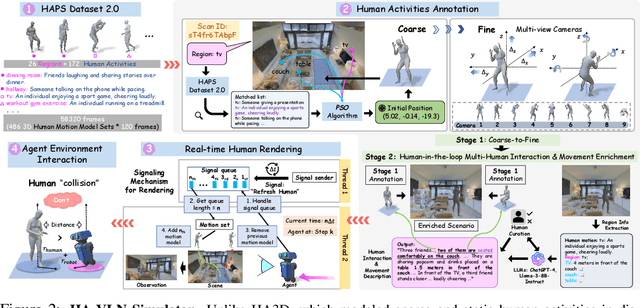
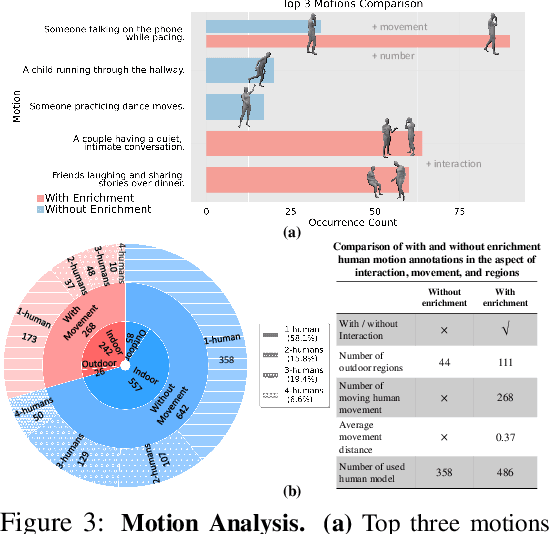

Abstract:Vision-and-Language Navigation (VLN) systems often focus on either discrete (panoramic) or continuous (free-motion) paradigms alone, overlooking the complexities of human-populated, dynamic environments. We introduce a unified Human-Aware VLN (HA-VLN) benchmark that merges these paradigms under explicit social-awareness constraints. Our contributions include: 1. A standardized task definition that balances discrete-continuous navigation with personal-space requirements; 2. An enhanced human motion dataset (HAPS 2.0) and upgraded simulators capturing realistic multi-human interactions, outdoor contexts, and refined motion-language alignment; 3. Extensive benchmarking on 16,844 human-centric instructions, revealing how multi-human dynamics and partial observability pose substantial challenges for leading VLN agents; 4. Real-world robot tests validating sim-to-real transfer in crowded indoor spaces; and 5. A public leaderboard supporting transparent comparisons across discrete and continuous tasks. Empirical results show improved navigation success and fewer collisions when social context is integrated, underscoring the need for human-centric design. By releasing all datasets, simulators, agent code, and evaluation tools, we aim to advance safer, more capable, and socially responsible VLN research.
MaxSup: Overcoming Representation Collapse in Label Smoothing
Feb 18, 2025
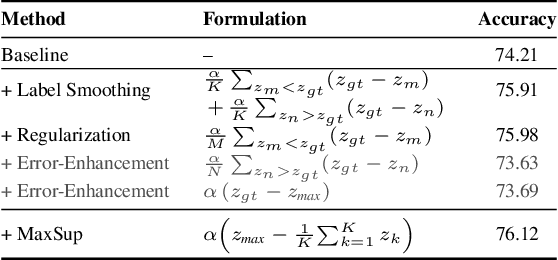
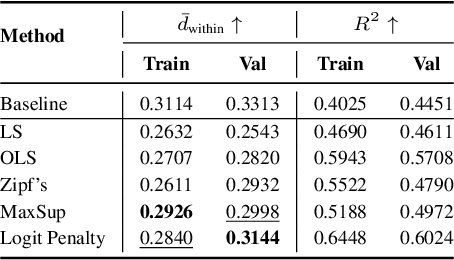
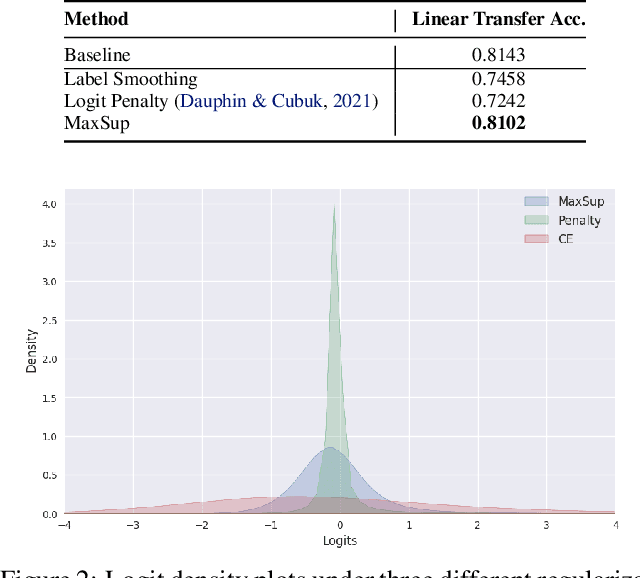
Abstract:Label Smoothing (LS) is widely adopted to curb overconfidence in neural network predictions and enhance generalization. However, previous research shows that LS can force feature representations into excessively tight clusters, eroding intra-class distinctions. More recent findings suggest that LS also induces overconfidence in misclassifications, yet the precise mechanism remained unclear. In this work, we decompose the loss term introduced by LS, revealing two key components: (i) a regularization term that functions only when the prediction is correct, and (ii) an error-enhancement term that emerges under misclassifications. This latter term compels the model to reinforce incorrect predictions with exaggerated certainty, further collapsing the feature space. To address these issues, we propose Max Suppression (MaxSup), which uniformly applies the intended regularization to both correct and incorrect predictions by penalizing the top-1 logit instead of the ground-truth logit. Through feature analyses, we show that MaxSup restores intra-class variation and sharpens inter-class boundaries. Extensive experiments on image classification and downstream tasks confirm that MaxSup is a more robust alternative to LS. Code is available at: https://github.com/ZhouYuxuanYX/Maximum-Suppression-Regularization.
SF-Loc: A Visual Mapping and Geo-Localization System based on Sparse Visual Structure Frames
Dec 02, 2024



Abstract:For high-level geo-spatial applications and intelligent robotics, accurate global pose information is of crucial importance. Map-aided localization is an important and universal approach to overcome the limitations of global navigation satellite system (GNSS) in challenging environments. However, current solutions face challenges in terms of mapping flexibility, storage burden and re-localization performance. In this work, we present SF-Loc, a lightweight visual mapping and map-aided localization system, whose core idea is the map representation based on sparse frames with dense (though downsampled) depth, termed as visual structure frames. In the mapping phase, multi-sensor dense bundle adjustment (MS-DBA) is applied to construct geo-referenced visual structure frames. The local co-visbility is checked to keep the map sparsity and achieve incremental mapping. In the localization phase, coarse-to-fine vision-based localization is performed, in which multi-frame information and the map distribution are fully integrated. To be specific, the concept of spatially smoothed similarity (SSS) is proposed to overcome the place ambiguity, and pairwise frame matching is applied for efficient and robust pose estimation. Experimental results on both public and self-made datasets verify the effectiveness of the system. In complex urban road scenarios, the map size is down to 3 MB per kilometer and stable decimeter-level re-localization can be achieved. The code will be made open-source soon (https://github.com/GREAT-WHU/SF-Loc).
PretextTrans: Investigating Medical Factual Knowledge Mastery of LLMs with Predicate-text Dual Transformation
Sep 22, 2024



Abstract:In the study, we aim to investigate current LLMs' mastery of medical factual knowledge with a dynamic evaluation schema, which can automatically generate multiple test samples for each medical factual knowledge point. Test samples produced directly by LLMs always introduce factual errors and lack diversity in the manner of knowledge expression. To overcome the drawbacks, here we propose a novel evaluation method, Predicate-text Dual Transformation (PretextTrans), by introducing predicate transformations into the dynamic evaluation schema. Specifically, each medical knowledge point is firstly transformed into a predicate expression; then, the predicate expression derives a series of variants through predicate transformations; lastly, the produced predicate variants are transformed back into textual expressions, resulting in a series of test samples with both factual reliability and expression diversity. Using the proposed PretextTrans method, we systematically investigate 12 well-known LLMs' mastery of medical factual knowledge based on two medical datasets. The comparison results show that current LLMs still have significant deficiencies in fully mastering medical knowledge, which may illustrate why current LLMs still perform unsatisfactorily in real-world medical scenarios despite having achieved considerable performance on public benchmarks. Our proposed method serves as an effective solution for evaluation of LLMs in medical domain and offers valuable insights for developing medical-specific LLMs.
iKalibr-RGBD: Partially-Specialized Target-Free Visual-Inertial Spatiotemporal Calibration For RGBDs via Continuous-Time Velocity Estimation
Sep 11, 2024



Abstract:Visual-inertial systems have been widely studied and applied in the last two decades, mainly due to their low cost and power consumption, small footprint, and high availability. Such a trend simultaneously leads to a large amount of visual-inertial calibration methods being presented, as accurate spatiotemporal parameters between sensors are a prerequisite for visual-inertial fusion. In our previous work, i.e., iKalibr, a continuous-time-based visual-inertial calibration method was proposed as a part of one-shot multi-sensor resilient spatiotemporal calibration. While requiring no artificial target brings considerable convenience, computationally expensive pose estimation is demanded in initialization and batch optimization, limiting its availability. Fortunately, this could be vastly improved for the RGBDs with additional depth information, by employing mapping-free ego-velocity estimation instead of mapping-based pose estimation. In this paper, we present the continuous-time ego-velocity estimation-based RGBD-inertial spatiotemporal calibration, termed as iKalibr-RGBD, which is also targetless but computationally efficient. The general pipeline of iKalibr-RGBD is inherited from iKalibr, composed of a rigorous initialization procedure and several continuous-time batch optimizations. The implementation of iKalibr-RGBD is open-sourced at (https://github.com/Unsigned-Long/iKalibr) to benefit the research community.
 Add to Chrome
Add to Chrome Add to Firefox
Add to Firefox Add to Edge
Add to Edge